High-quality backlinks remain central to search visibility, yet the measurable impact of domain strength on rankings continues to be debated. That’s the gap Search Atlas set out to close.
I, Manick Bhan, together with the Search Atlas research team, analyzed 350,159 backlink placements across 13,002 landing pages, pairing backlink data, domain metrics, and Google Search Console (GSC) performance to measure how links change visibility at the page level.
The study defines how backlinks affect rankings, traffic, impressions, and keyword coverage. Backlink impact refers to how pages gain visibility after acquiring links. Backlink impact matters because it determines whether link investments generate real ranking lift.
The study investigates Domain Power (DP), Domain Rating (DR), and Domain Authority (DA) to quantify which domain signals predict SEO outcomes most reliably. The study matters because backlinks remain a core driver of organic growth, but not all links perform equally.
What Are the Final Takeaways?
I, Manick Bhan, along with the Search Atlas research team, ran experiments to quantify how backlinks change measurable SEO performance across domains. The summarized page-level findings are listed below.
- Keywords: +150 percent growth per page.
- Impressions: +275 percent visibility gain.
- Traffic: +14 percent increase in clicks.
- Average Position: +10.8 percent improvement.
The analysis identifies Domain Power as the strongest predictor of page-level gains, outperforming Domain Rating and Domain Authority across all outcomes.
Backlinks from high-DP domains consistently outperformed links from lower-tier sources. One link from a strong domain produced more measurable lift than multiple links from weaker ones.
Anchor text relevance also increased after placement, confirming that contextual alignment between link text and target-page keywords multiplies ranking gains.
Marketers who prioritize domain strength and semantic alignment in their link strategies achieve higher ROI, stronger authority signals, and sustained visibility.
Methodology: How Did We Conduct the Analysis?
The study done by Search Atlas applies statistical and machine-learning methods to measure backlink performance before and after placement.
Machine learning (ML) refers to model training from real data. ML produces feature-importance scores that quantify which signals best predict SEO outcomes. ML matters because it isolates the causal strength of each domain metric.
The researchers from Search Atlas use the XGBoost regression algorithm. XGBoost delivers robust feature weighting and non-linear accuracy. XGBoost matters because it exposes hidden relationships between domain quality and ranking behavior.
The preprocessing steps are listed below.
- Apply time-based filters to classify “before” and “after” placement phases.
- Remove outliers and zero-inflated values to maintain viable samples.
- Normalize continuous variables for regression modeling.
- Segment domains into percentile bins ([20,30), [30,40), … [90,100]) for authority tiers.
The analytical methods are listed below.
- Descriptive comparisons of before/after performance shifts.
- Wilcoxon Rank-Sum tests to confirm statistical significance.
- Linear regression models to isolate domain metric effects.
- XGBoost models to capture non-linear interactions and feature importance.
- Text similarity analysis to measure semantic relevance of anchor text.
The target variables are 4 SEO metrics: impressions, traffic, keyword coverage, and average position.
What Does the Global Analysis Show?
According to the global analysis conducted by Search Atlas, backlinks produce statistically significant improvements across every key SEO metric.
The results for all pages combined are listed below.
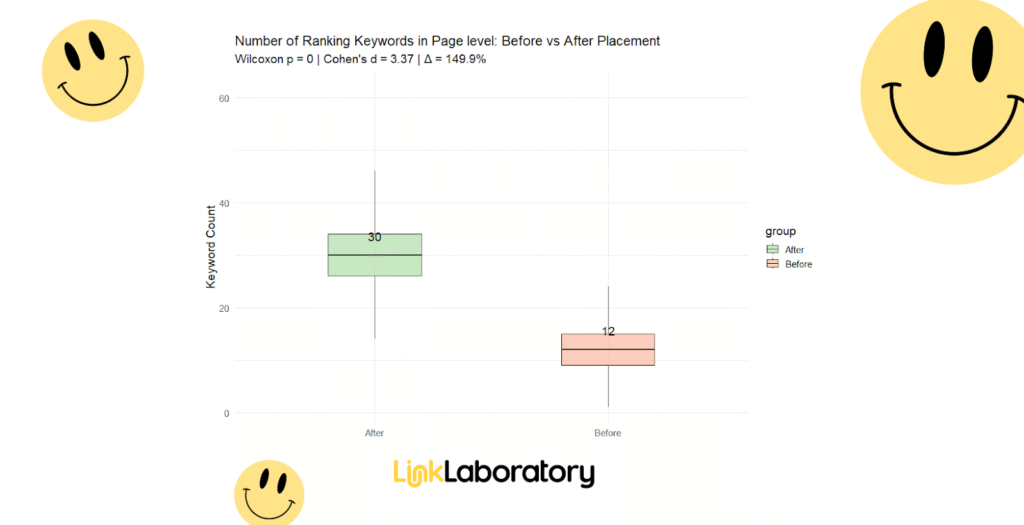
- Ranking Keywords (+150 percent): Pages expanded from 12 to 30 keywords on average. The effect size (Cohen’s d = 3.37) confirmed a large practical impact.
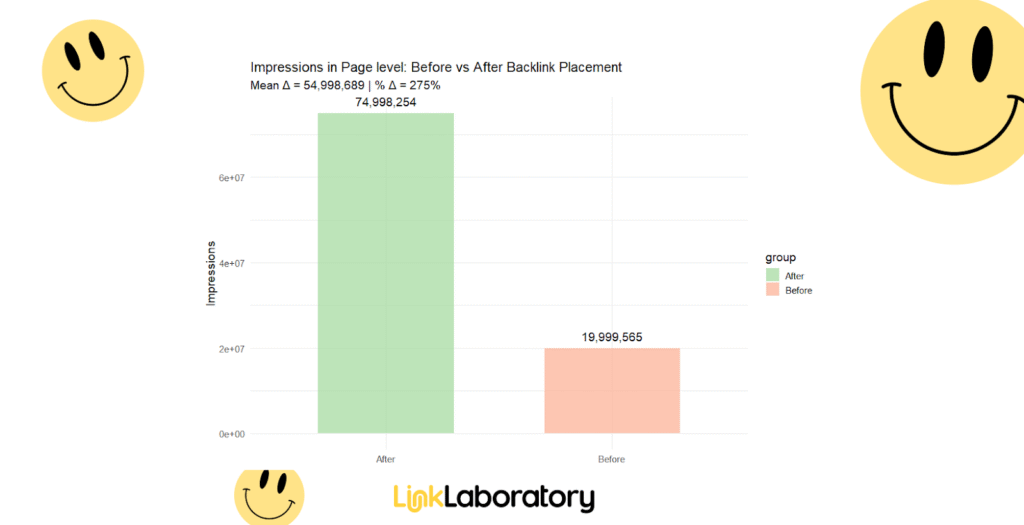
- Search Impressions (+275 percent): Visibility surged from 20 million to 75 million impressions per page. The Wilcoxon test (p < 0.001) confirmed significance.
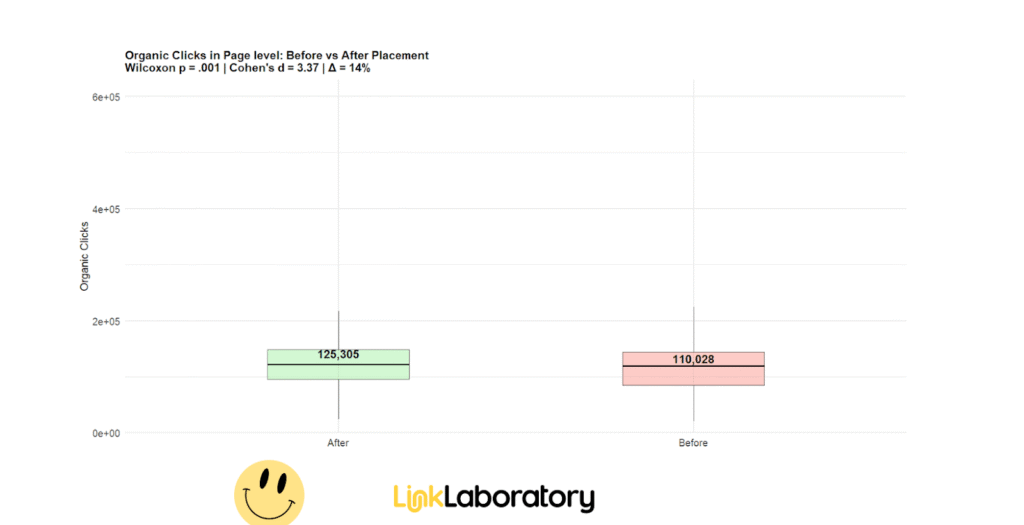
- Organic Clicks (+14 percent): Median clicks increased from 110,000 to 125,000 per page. Improved rankings converted visibility into measurable traffic.
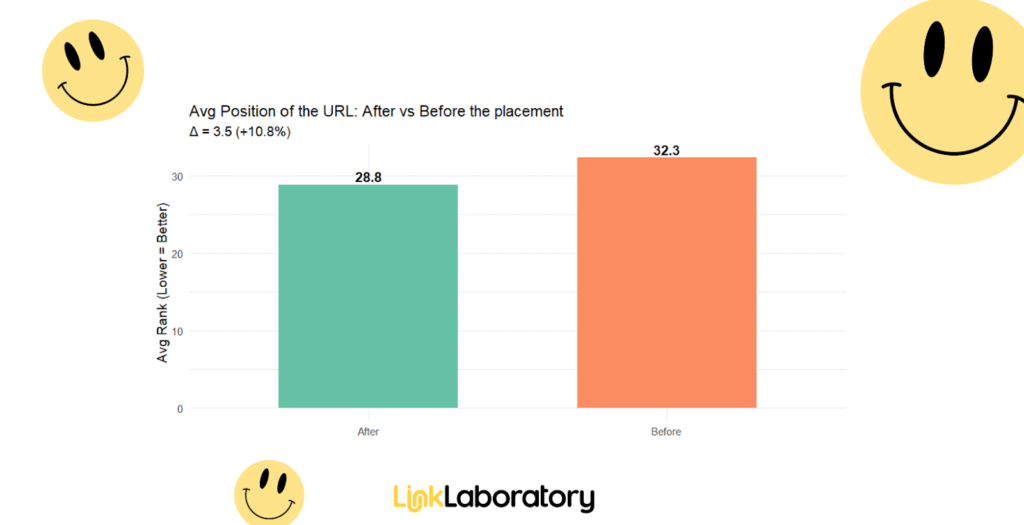
- Average Position (+10.8 percent): Pages moved from 32.3 to 28.8 in search results—a 3.5-position gain that substantially increases click-through probability.
Which Domain Metrics Are Compared In the Study?
3 domain metrics were compared to determine which best predicts SEO outcomes. The 3 domain metrics are listed below.
- Domain Power (DP) from Search Atlas.
- Domain Authority (DA) from Moz.
- Domain Rating (DR) from Ahrefs.
Domain Power measures real-world SEO impact by combining link velocity, referring-domain diversity, and historical traffic uplift. The model explained how each metric contributes to traffic, impressions, and ranking improvements before and after placement.
The summarized results of each domain metrics are below.
Domain Power (DP)
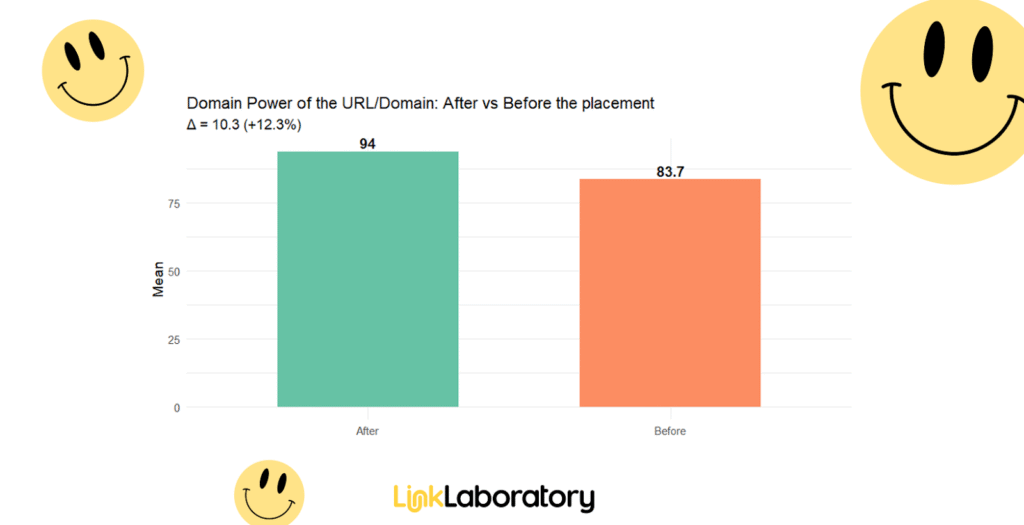
- Traffic: coefficients rose from 20,000 to 40,000 in top bins.
- Impressions: linear increase across all bins.
- Position: strongest and most consistent gains, exceeding 18 points in top tiers.
Domain Authority (DA)
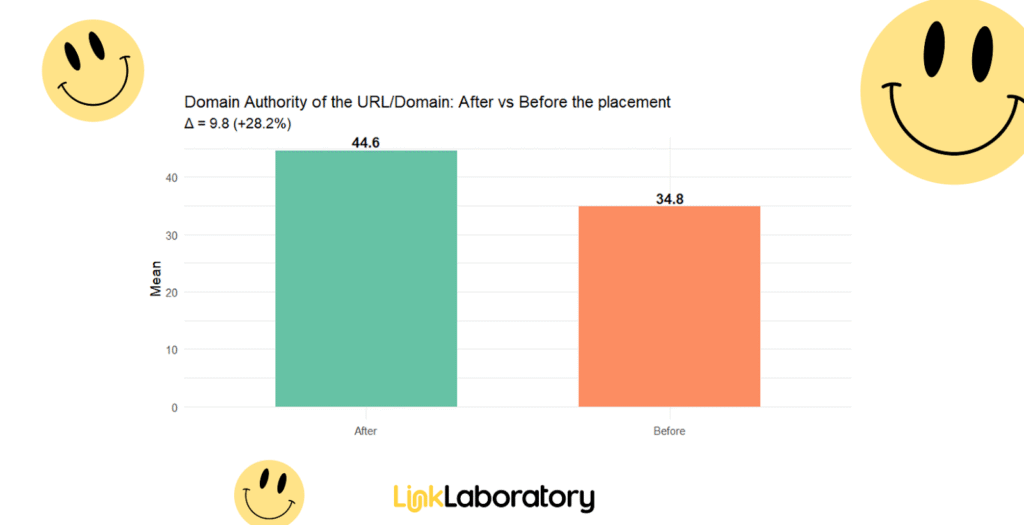
- Traffic: modest gains only in top 30 percentile bins.
- Impressions: steady growth above 60 percentile.
- Position: improvements appeared only after placement.
Domain Rating (DR)
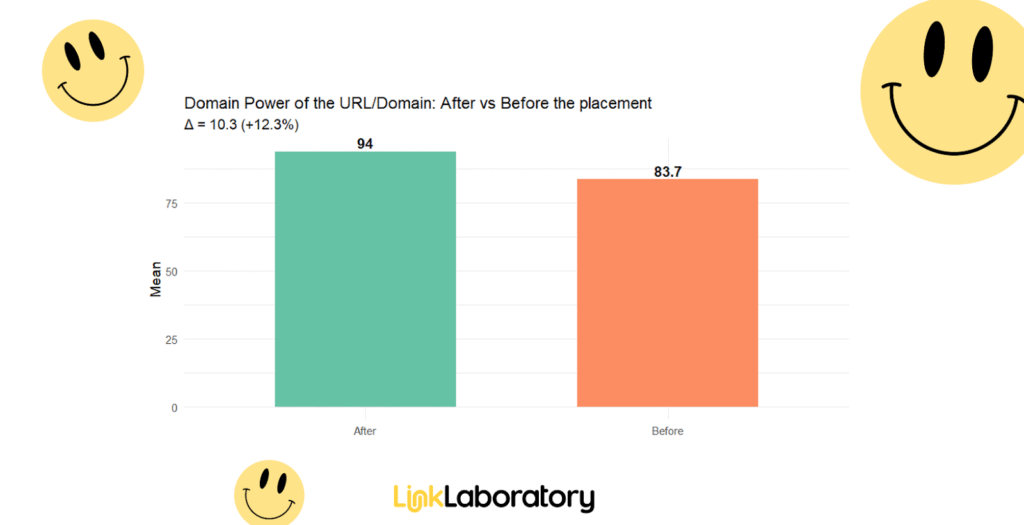
- Traffic: visible increase in higher bins but inconsistent.
- Impressions: minor lift above 70 percentile.
- Position: measurable gains only post-placement.
Domain Power remained the dominant predictor before and after placement. DP captured ranking and visibility changes more accurately than DA or DR.
What Happens After Placement?
Backlink placement strengthens both referring and target domain metrics. The average changes observed across all URLs are listed below.
- Domain Power: +10.3 points (+12.3 percent) → 83.7 to 94.
- Domain Rating: +22.7 points (+30.8 percent) → 73.7 to 96.4.
- Domain Authority: +9.8 points (+28.2 percent) → 34.8 to 44.6.
These increases confirm that placements target progressively higher-quality domains, reinforcing site-wide authority.
How Does Machine Learning Explain the Results?
The XGBoost model measured how each domain metric predicts 3 core outcomes: organic traffic, impressions, and average position. The outcomes of the metrics are below.
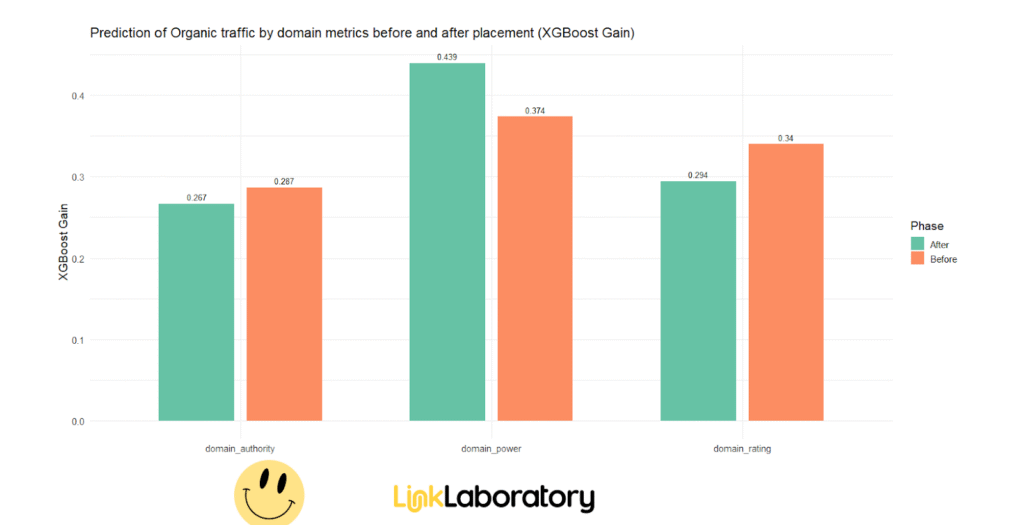
- Organic Traffic Prediction: Before placement: DP = 0.374 gain score > DR = 0.34 > DA = 0.287. After placement: DP rises to 0.439, while DR drops to 0.294 and DA to 0.267.
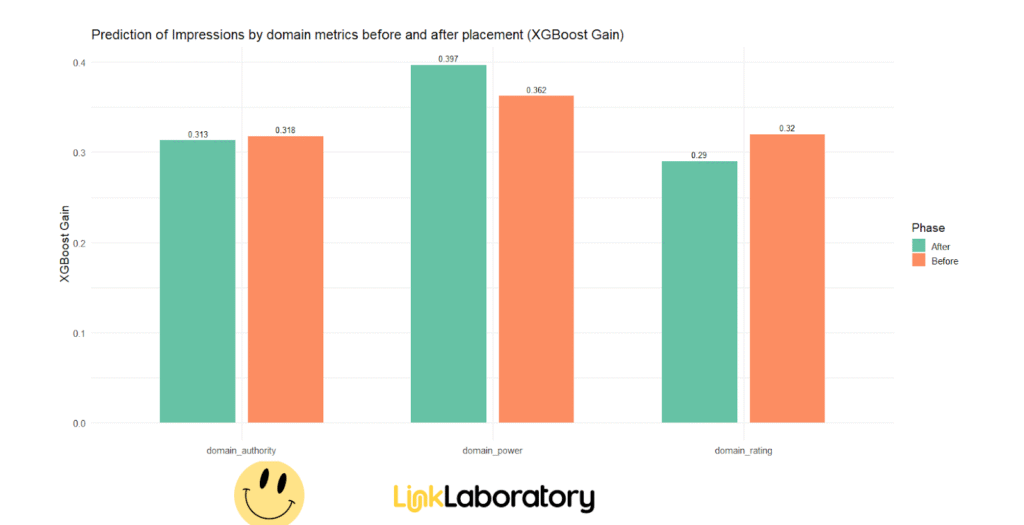
- Impression Prediction: DP gain increases from 0.362 to 0.397. DR and DA decline slightly.
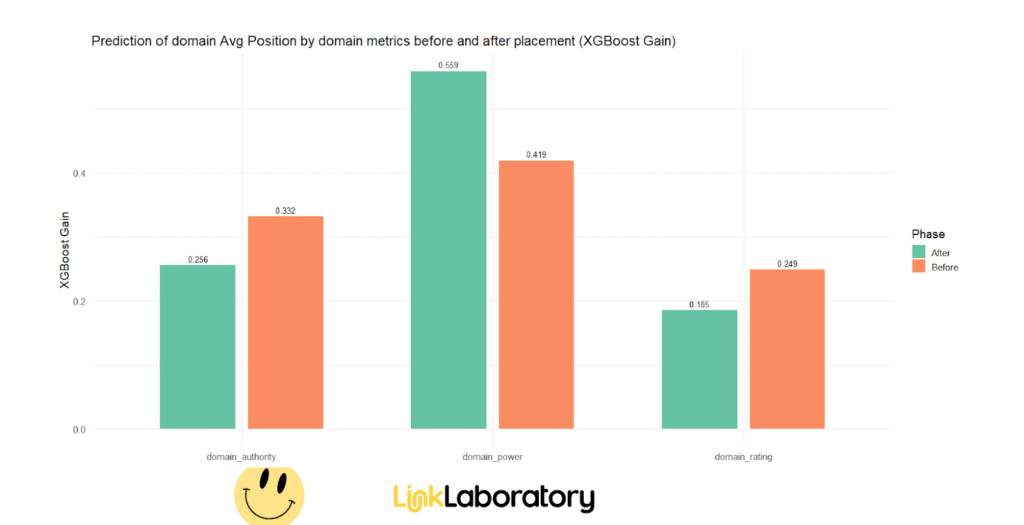
- Average Position Prediction: DP gain climbs from 0.419 to 0.559. DR falls to 0.185.
What Does the Anchor Text Analysis Show?
Anchor text acts as a contextual signal that connects the referring and target pages. Semantic alignment between anchor text and ranking keywords increased substantially after placement.
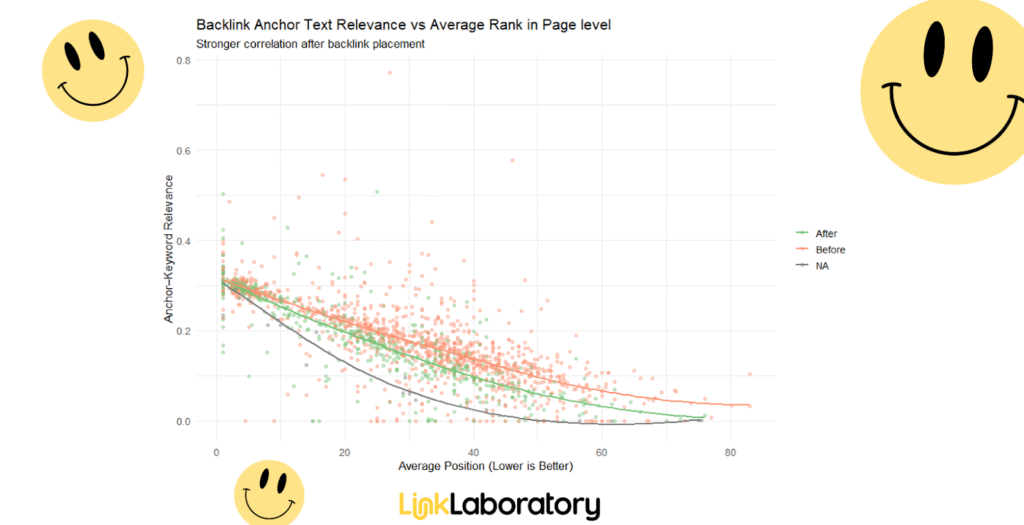
The results of the Semantic alignment between anchor text and ranking keywords are listed below.
- Semantic Similarity (+69.6 percent): From 0.415 to 0.703 (p = 1.61 × 10⁻²²).
- Ranking Correlation (R²): From 0.564 to 0.745.
- Pearson Correlation Strength: From −0.75 to −0.86.
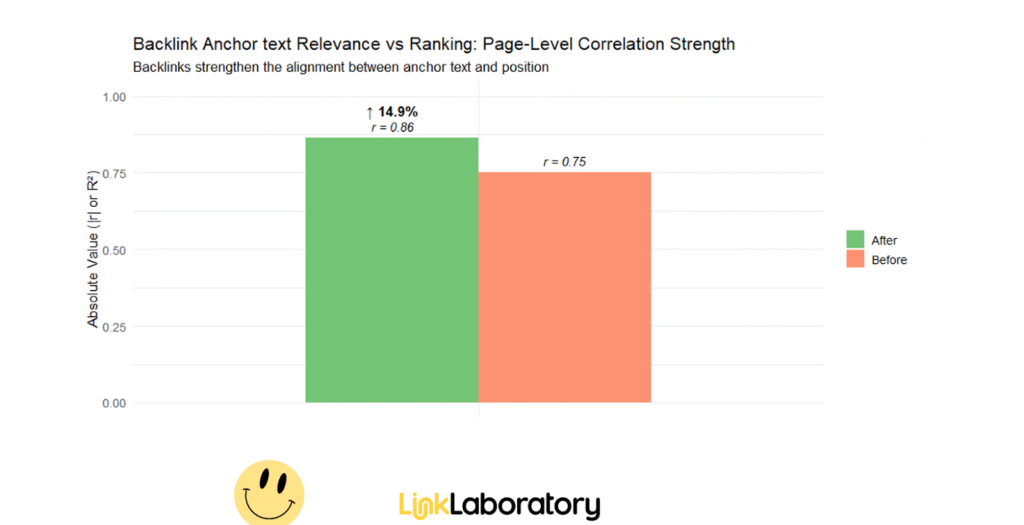
Anchors that mirror the topical intent of target pages produced higher rankings. Contextual relevance amplified the effects of domain strength, proving that link context and quality work in tandem.
What Should SEO Teams Do with These Findings?
The analysis confirms that backlinks remain central to growth, but not all links are equal. To turn these results into practice, SEO teams should align efforts with the levers that consistently delivered the highest returns.
The actionable recommendations SEO teams are able to do with the findings are below.
- Prioritize Domain Power: Target referring domains with strong DP scores. Domain Power captures the combined effects of authority, trust, and historical impact.
- Focus on Contextual Relevance: Craft anchor text that semantically aligns with page keywords. Relevant anchors amplify both ranking and visibility.
- Measure Results at the Page Level: Track performance before and after placement. Evaluate keyword growth, impressions, and average position per URL.
- Invest in Fewer, Higher-Quality Links: Replace quantity-driven strategies with selective, high-impact placements. Quality links yield higher ROI and sustained traffic growth.
- Use Domain Power as a Benchmark: DP predicts outcomes more accurately than DA or DR. Incorporate it into outreach and evaluation workflows.
How Does The Results Compare to Industry Wisdom?
The study confirms long-standing SEO principles that backlinks improve rankings but quantifies how much and why. It validates the importance of link quality, contextual relevance, and authority metrics while exposing the limits of volume-based link building.
Domain Power explains a larger share of outcome variance because it incorporates both link velocity and trust signals—factors missing from DA and DR. The results show that modern SEO demands quality-driven link acquisition informed by real data.
What Could Be the Limitations of the Study?
Every analytical model has boundaries. The limitations identified are listed below.
- External conditions such as algorithm updates or seasonal traffic patterns may influence outcomes.
- Proprietary domain metrics evolve over time and may shift as datasets update.
- The before-and-after approach reduces but does not eliminate causality uncertainty.
- Results aggregate across industries; individual sectors may exhibit variation.
The dataset size and statistical significance confirm robust, repeatable relationships between backlink quality and SEO lift despite these limits.
What Are the Final Insights?
Backlinks remain one of the most reliable and quantifiable drivers of SEO growth. The data show that Domain Power predicts visibility, rankings, and traffic more accurately than competing metrics.
Pages that earn backlinks from high-DP, semantically aligned domains achieve sustained ranking improvements. Quality links, strategically placed, continue to define the difference between visibility and obscurity.
Businesses that adopt data-driven link acquisition frameworks and measure performance at the page level secure measurable, repeatable SEO lift.